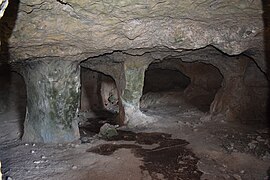Sa Cudia Cremada
| Sa Cudia Cremada Poblat talaiotic de sa Cudia Cremada | ||
|---|---|---|
|
A hypogeum in Sa Cudia Cremada |
||
|
Location in Menorca |
||
| Coordinates | 39 ° 52 '48.5 " N , 4 ° 14' 35.2" E | |
| place | Maó , Balearic Islands , Spain | |
| Emergence | 1050-850 BC Chr. | |
| Dimensions | 200 m | |
| height | 73 m | |
Sa Cudia Cremada (full name Poblat talaiòtic de sa Cudia Cremada, "Talaiotic village of sa Cudia Cremada") is an archaeological excavation site named after the land of the same name on the outskirts of Maó , the capital of the Balearic island of Menorca .
The archaeological remains of this site belong to the Talayotic culture , which peaked in the Bronze and Iron Ages. Archaeological surface finds prove the Roman occupation of Menorca in the second and first centuries BC. The numerous Islamic clay fragments found indicate that the settlement of Sa Cudia Cremada was still inhabited in the Middle Ages.
A five-year excavation campaign began in 2015 . The talayotic village of Cornia Nou is about 800 m further west.
Finds
The site is in excellent condition and has some well-preserved remains of buildings. The most important of these are three talayots , thick-walled towers in Cyclopean style, the walling of the sacrificial site, several graves, a pit that was probably used as a warehouse for goods, as well as some parts of a megalithic wall .
The foundation of the easternmost talayot is oval and 19 m in diameter. Its sloping facade faces south and has access to a central chamber, the roof of which, consisting of large stone slabs, has been partially preserved. The remains of the settlement are approx. 200 m away from this tower and have another oval talayot with a diameter of 20 m and a maximum height of 5 m. The south-facing facade of the tower contains steps that can also be found in similar structures in such sites, e.g. B. in the talayot of Sa Cornia Nou . Another 1.5 m high wall was found here.
The third talayot is slightly smaller, has a circular foundation and access to the central chamber, which is now filled with rubble from the tower's masonry. On the north facade of the talayot, a rectangular masonry can be seen, the function of which has not yet been clarified.
The most important structure in the entire settlement is located near this third talayot. It was the place of sacrifice of the settlers, or rather, the walling of the taula in the form of an apse . This masonry was built using Cyclopean construction technology, the direction points to the south and the facade is slightly curved (concave). In the apse was the taula, a T-shaped monument consisting of two stones and typical of the religious cult on Menorca. The excavations, which began in 2015, have uncovered the remains of what is believed to be the deliberately broken load-bearing stone of the taula.
The other well-preserved architectural structures are: parts of megalithic walls that run east to west; a deep pit covered with a stone slab, various graves and man-made caves that were partially carved into the rock and served as a collective grave.
- Views of Sa Cudia Cremada
Nomination for World Heritage List
Sa Cudia Cremada is one of the 32 archaeological sites that Spain officially proposed on January 14, 2016 as " Talayotic Culture of Menorca " for inclusion in the UNESCO World Heritage List . The World Heritage Committee postponed the application at its 41st meeting in July 2017 and requested improvements.
Web links
- Sa Cudia Cremada talayotic settlement on the Menorca Talayótica website
Individual evidence
- ↑ M. Anglada Fontestad, C. Bravo Asensio, I. Riudavets González: Les EXCAVACIONS en el Recinte de taula sa Cudia Cremada . In: ÀMBIT . tape 38 , 2016, p. 4–7 (Catalan, cime.es [PDF; 2.7 MB ]).
- ↑ Montserrat Anglada, Irene Riudavets, Cristina Bravo: Uncovering the Mediterranean's Monumental Prehistory: A Taula Sanctuary . In: Popular Archeology 23, summer 2016.
- ↑ M. Anglada Fontestad, C. Bravo Asensio, I. Riudavets González: Sa Cudia Cremada. Tercera campanya d'excavacions . In: ÀMBIT . tape 48 , 2018, p. 10–12 (Catalan, cime.es [PDF; 12.4 MB ]).
- ↑ The monuments in the nomination on the website Menorca talaiòtica des Consell Insular de Menorca (English), accessed on May 10, 2017
- ↑ World Heritage Committee (Ed.): List of nominations received by February 1, 2016 and for examination by the World Heritage Committee at its 41st session (2017) . (English, unesco.org [PDF; 427 kB ]).
- ↑ World Heritage Committee (Ed.): Decisions adopted during the 41st session of the World Heritage Committee (Krakow, 2017) . (English, unesco.org [PDF; 4.5 MB ]).






